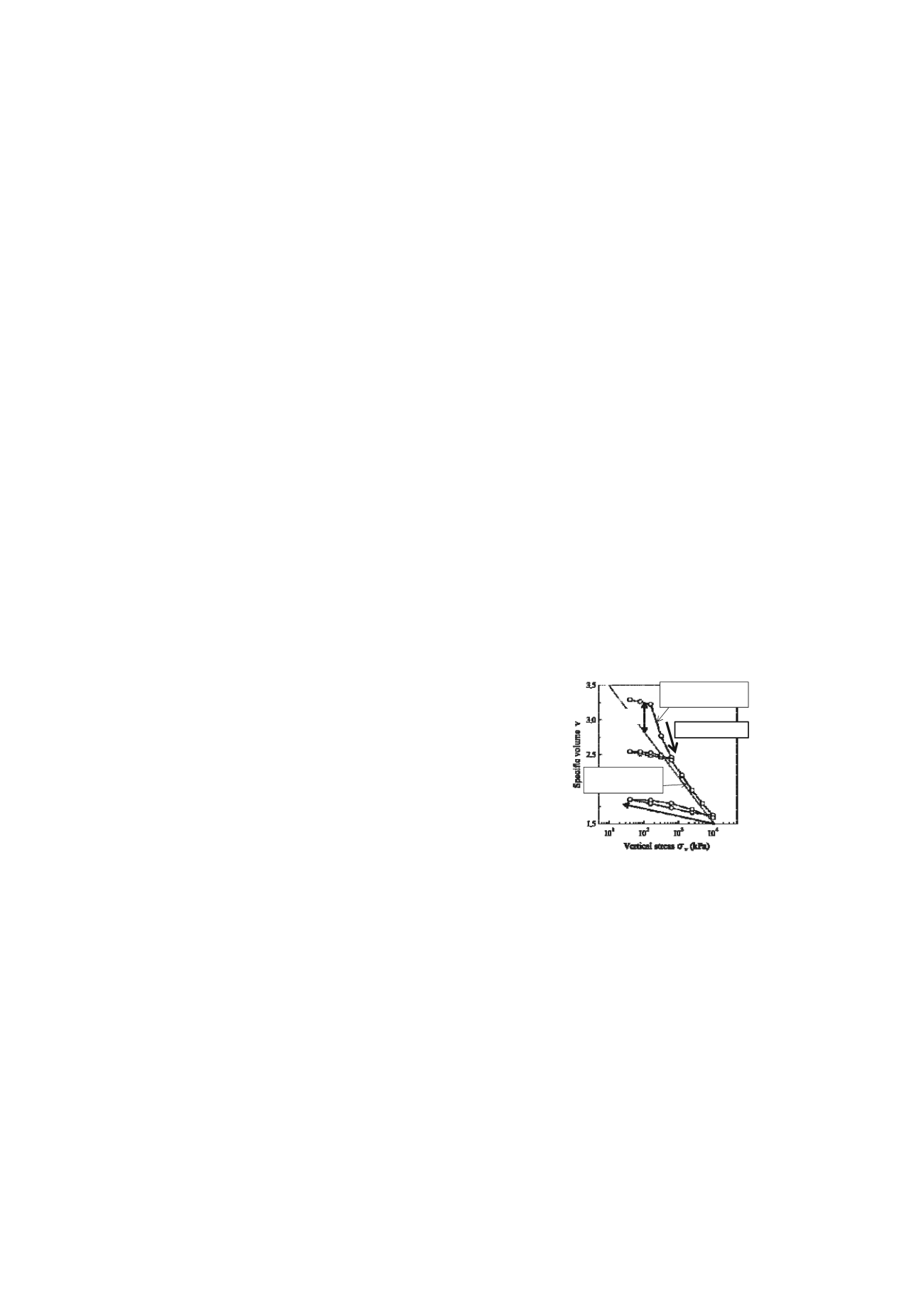
3239
Interpretation of mechanical behavior of cement-treated dredged soil based on soil
skeleton structure
Interprétation des comportements mécaniques des sols dragués traités au ciment basée sur la
structure squelette du sol
Nakano M., Sakai T.
International Member, Nagoya University,JAPAN
ABSTRACT: The objective of this study was to examine the mechanical behaviors of cement-treated dredged soil and evaluate them
based on action of the soil skeleton structure through simulation of the behaviors by the SYS Cam-clay model. Besides, the behaviors
were simulated by the
GEOASIA
soil-water coupled finite deformation analysis code. The new findings are summarized as follows;
1) As the soil is treated with high cement with low initial water content under shearing in high confining stress, its effective stress
path moves up closer to the tension cut-off before failure. 2) The treated soil approaches the NCL of the remolded cement-treated soil.
3) The treated soil is regarded as a high structure and overconsolidated soil. 4) FEM analysis can describe softening behavior with
shear banding through the triaxial compression test.
RÉSUMÉ: L'objectif de cette étude est d'examiner les comportements mécaniques de sols dragués traités au ciment et de les évaluer
sur la base de l'action de la structure de squelette du sol par la simulation des comportements à l'aide du modèle SYS Cam-clay. Par
ailleurs, les comportements sont simulés par GEODESIA, un programme d'analyse de déformations finies sol-eau couplées. Les
nouveaux résultats sont résumés comme suit; 1) Comme le sol est traité avec du ciment haut à teneur en eau initiale faible avec
cisaillement sous contrainte de confinement élevé, son chemin de contrainte effective se déplace plus près de la tension de coupure
avant la rupture. 2) Le sol traité se rapproche de la NCL du sol traité au ciment et remoulé. 3) Le sol traité est considéré comme une
structure haute et surconsolidée. 4) L'analyse par éléments finis peut décrire des comportements d'adoucissement avec bande de
cisaillement lors d'essai de compression triaxiale.
KEYWORDS: cement stabilization, soil skeleton structure, elasto-plastic mechanics.
1 INTRODUCTION
About 1.3 million m
3
of dredged soil is produced annually in
Nagoya Bay. However, the temporary storage capacity for the
soil at Nagoya Port Island (PI) is limited, so effective use of the
soil as a geomaterial has become a pressing issue. The water
content of the soil is high, and the unconfined compressive
strength is low, so to effectively use the soil as a geomaterial, it
is necessary to add a stabilizer such as cement to improve the
mechanical properties. Therefore, in this study, the mechanical
behavior of cement-stabilized dredged soil (hereafter referred to
as treated soil) was determined using laboratory tests and
reproduced using an elasto-plastic constitutive model, with the
objective of explaining the improvement effect.
Past constitutive equation study into cement-stabilized soil
includes, for example, the study by Hirai et al. (1989), Yu et al.
(1998), Kasama et al. (2000), Lee et al. (2004), and Wada et al.
(2004). This study used the SYS Cam-clay model (Asaoka et al.
2002), an elasto-plastic constitutive model based on the action
of the soil skeleton structure. It was assumed that the
mechanical behavior for the criteria to define the soil skeleton
structure was the mechanical behavior obtained from remolded
samples of treated soil (hereafter referred to as remolded treated
soil). The one-dimensional compression behavior was
reproduced in addition to the shear behavior in order to explain
the improvement effect of adding cement based on elasto-plastic
mechanics, taking the soil skeleton structure into consideration.
In addition, the effect of nonuniform deformation on triaxial test
results was investigated by solving as a boundary problem
(Asaoka et al. 1995), taking into consideration brittle behavior,
which is a characteristic of the treated soil that was observed in
the tests, in addition to the constitutive equation response
considering the triaxial test to be an element test.
Compression line of
remolded clay
「
Overconsolidation
」
Loss of structure
Compression line of
naturally deposited clay
「
Structure
」
Figure 1. One-dimensional compression of natural deposited clay and
definition of structure and overconsolidation
1 THE SYS CAM-CLAY MODEL
This section describes the SYS Cam-clay, the elasto-plastic
constitutive model that was used to explain the mechanical
behavior of the treated soil. Fig. 1 shows the oedometer test
results for natural deposited clay and remolded clay. Natural
deposited clay is defined as clay with structure, where the
difference in specific volume
v
(
; is the void ratio)
from remolded clay at the same vertical stress, in other words,
the “bulk” is taken to be the extent of structure. As the vertical
stress increases, the compression line of the natural deposited
clay approaches that of remolded clay. The interpretation of this
behavior in terms of the concept of soil skeleton structure is that
there is decay/collapse of the soil structure due to shearing
(plastic deformation) of the soil. A triaxial compression test is
not shown here, but the critical state of natural deposited clay
gradually approaches that of remolded clay as a result of shear.
Basically, the structure collapses due to shear. Likewise,
overconsolidation becomes normal consolidation as a result of
e
1
e


